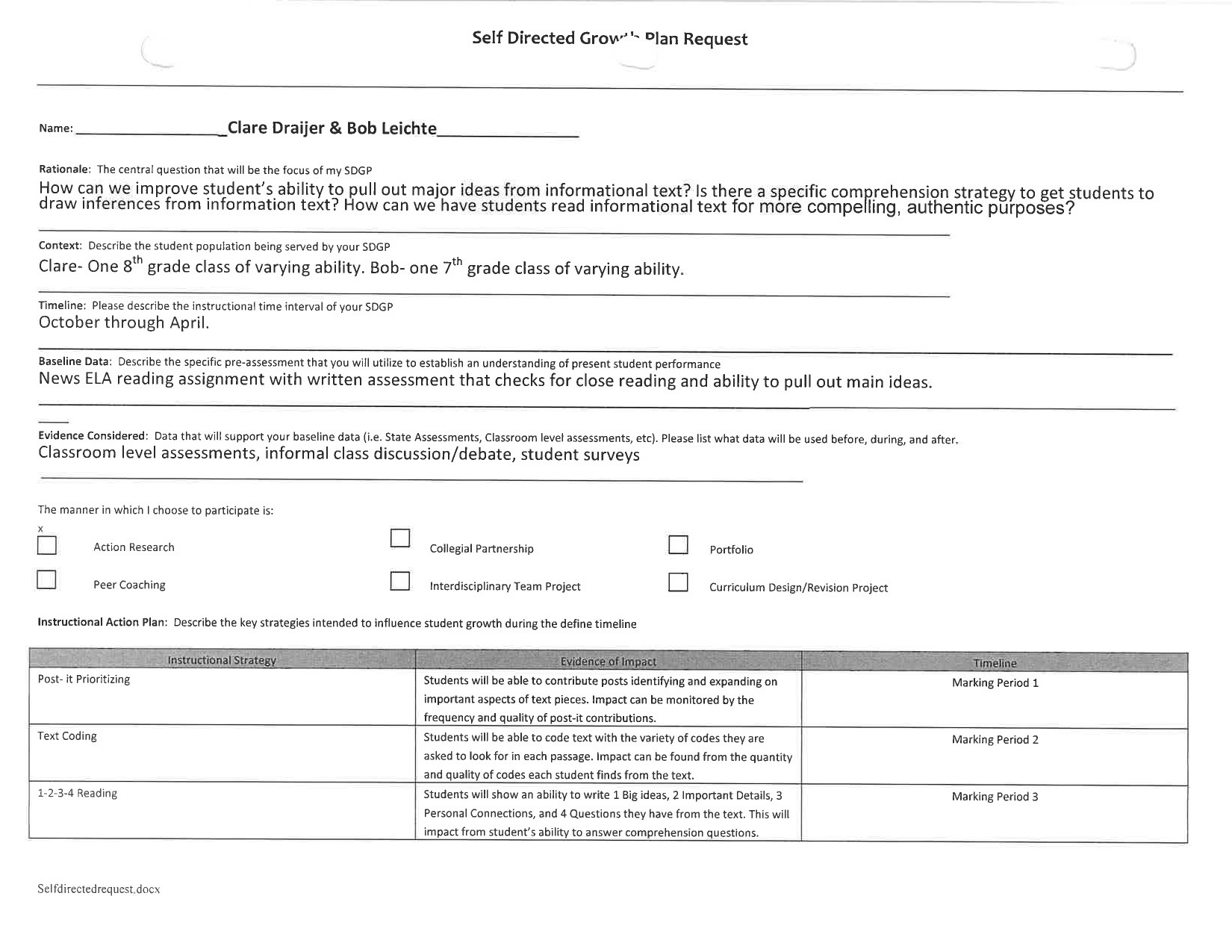The National Commission on Teaching and America’s Future indicates that more than fifty percent of those entering the profession will leave within the first three to five years. Poor teacher evaluation, feelings of isolation, and little opportunity to share expertise with each other are a few of the reasons that contribute to the loss of good teachers.
Nine years ago, the Harrington Park School District in New Jersey started down a path of reevaluation and self reflection, when we realized that we were in danger of losing teachers. We needed to “reevaluate the evaluation”—to figure out how we could bring teachers together over evaluation, as opposed to driving them apart.
The answer? The Self-Directed Growth Plan (SDGP)—an approach to teacher evaluation and student growth measurement that allows for a continual state of growth and change that effective teachers desire to gain.
The path we took is one that we’d like to share with you, if you’re willing to take that first step. I’ve always analogized that any change in public education is like that first step off a cliff—it’s that deep breath we all take in filling our lungs getting ready for what is to come. For those brave enough to take that step, here’s what I promise you at the bottom of that cliff: an empowered community willing to undertake any challenge.
Thinking Outside the Checkbox
Prior to initiatives like AchieveNJ, PARCC, and state mandates, the Harrington Park School District had wanted to reinvent the way their teachers were evaluated all the way back in 2010. The impetus for this change stemmed from experienced teachers wishing that the time they spent preparing for formal observations could be put to better and more meaningful use. Likewise, administrators wondered how they could help support the growth of their veteran teachers.
The two groups—teachers and administrators—came together and decided that the traditional teacher observation system needed to be restructured. What emerged from their effort was a long-term observation model unlike any other. Driven by research, student data, and teacher collaboration, the Self-Directed Growth Plan (SDGP) works to improve teaching and ultimately student growth.
And when we say research, we mean research. Because we wanted SDGPs to allow staff the ability to see from the balcony, while allowing them the ability to direct their learning and receive support through their own growth stages, we took to Fullan & Stiegelbauer’s 1991 “The New Meaning of Educational Change” study. From it, we learned that the type of learning we wanted to achieve for our educators calls for long-term implementation that occurs consistently and continually over a period of time. So, we got to work.
What is a “Self-Directed Growth Plan”?
The Self-Directed Growth Plan, or SDGP model, is based on the belief that like children, adults learn in different ways—and therefore, a differentiated approach to teacher growth is necessary.
Rather than participating in the traditional observation model, self-directed growth plans allow experienced teachers to be evaluated alternatively. Teachers create clear, measurable objectives based on current needs and data in their classrooms. Plans on how to achieve the desired objectives are created (with the required Student Growth Objectives embedded) and take the shape of action research, peer coaching, collegial partnerships, interdisciplinary team projects, portfolios, curriculum design/revision, or other mutually agreed-upon models. (See example below.)

Whereas failures in other types of observations can result in a negative evaluation, a “failure” in the SDGP process allows the opportunity for teachers to modify their practice. Regardless of the outcome of the SDGP, it is always a success because its participants continue to reflect and grow as professionals within the education field.
Making the SDGP and Learning Together
Let’s talk steps from the start of an academic year to its finish. At the start of each school year, groups begin to form based on the areas in which individual teachers would like to focus, such as 7th grade science, physical education, or world languages. A plan of action is written, and groups (trust us, this isn’t a “lone wolf” situation) meet with administrators to further develop the desired area of concentration.
As the year progresses, SDGPs grow, change and get fine-tuned as educators collect data and implement their plan(s) in the classroom. At the close of each school year, groups must present and defend their SDGP to a panel of important school leaders. Feedback is given and groups can then decide if their SDGP is complete or if it needs to be developed further throughout the following school year. Harrington Park staff wanted the the opportunity to share their findings to one another, hence making this project a “living document” that can be supported and grown with the assistance of administration. In that sense, teachers at Harrington Park School are empowered to take risks in finding ways to improve student achievement because they have the trust and support of their administration and school board.
Because the idea for the plan comes from the teachers, and is not dictated by administrators, the teachers have a strong sense of ownership that leads to a highly-developed and in-depth product. Additionally, the ongoing support and close relationships formed by teams through SDGPs help to keep new teachers (as well as veteran teachers) from becoming isolated. Educators share teaching practices, make results transparent, engage in critical conversations about improving instruction, and institutionalize continuous improvement.
In-Depth Example: World Language Department’s SDGP
With financial woes continuously swallowing school districts that desire to score well on state measurements, many states’ present evaluation systems drive cuts being made to important subject areas. Music, Art, World Languages and other untested subjects tend to be among the first to be cut because they are not the power subjects that define district success rates on standardized testing. But at Harrington, this is where the SDGP finds its home.
Our World Language Department based their SDGP plan on language development theory. According to Second Language Acquisition principles, there is a direct correlation between success in first language acquisition and second language acquisition; students who struggle in their first language tend to struggle in their second language. So, our teachers worked together to develop a SDGP plan that incorporates the “writer’s workshop” concept into both foreign language and English Language Arts courses.
Despite their different backgrounds, each set of teachers benefitted. World language teachers worked with English language arts (ELA) teachers to focus in on how they can impact and influence other subject areas through a change in their own instructional practice. In the most recent SDGP case, they examined the use of mentor texts within Spanish and determined how to best collect data across disciplines to show growth within a student’s reading and writing portfolio. In fact, both sets of teachers—ELA and foreign language—recognize the importance of tracking writing and reading stamina, and this SDGP encourages them to do so.
The SDGP’s Bright Future
The concept of the SDGP is not intended to suggest a deficiency on the part of our profession. On the contrary, we believe that the SDGP has been developed to be the instrument through which we as a district express our expectations for both personal and professional growth.
The scope of future plans for the SDGP process is vast and unlimited, and as we look to the future, we see a possible path for the SDGPs to fit into our work with recertification and micro-credentials. For us, teacher evaluation and training isn’t about seat-time—it’s about learning and competencies.
But even beyond teacher training, the SDGP’s true value is in the way it encourages collaboration—a key to promoting student growth and achievement. With the SDGP model, we are able to measure effectiveness through essential questions that can be seen almost immediately. At Harrington, we’ve done away with mundane and redundant evaluations that add to existing isolation and anxiety of educators.
Now, the question is… will you?


